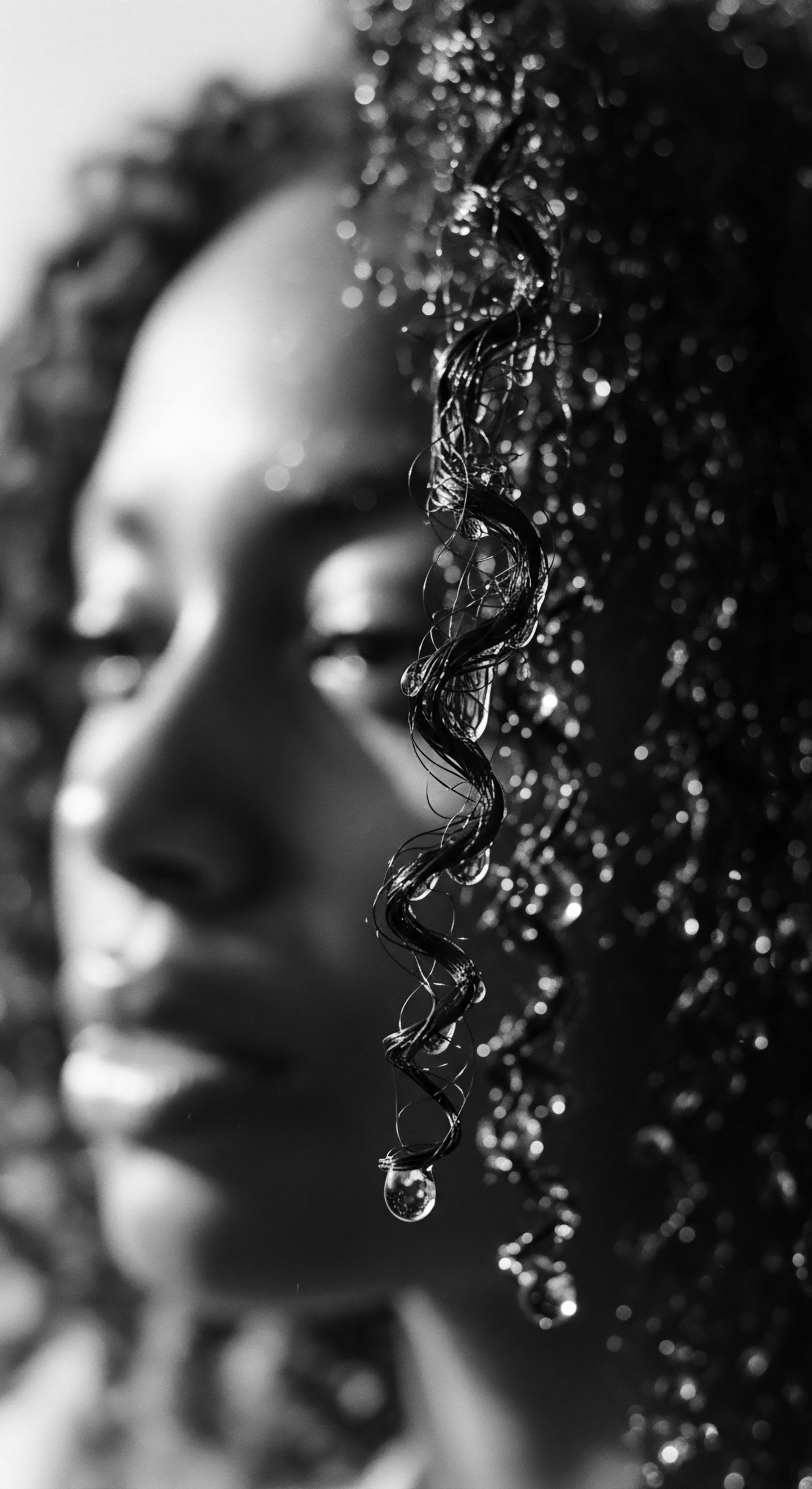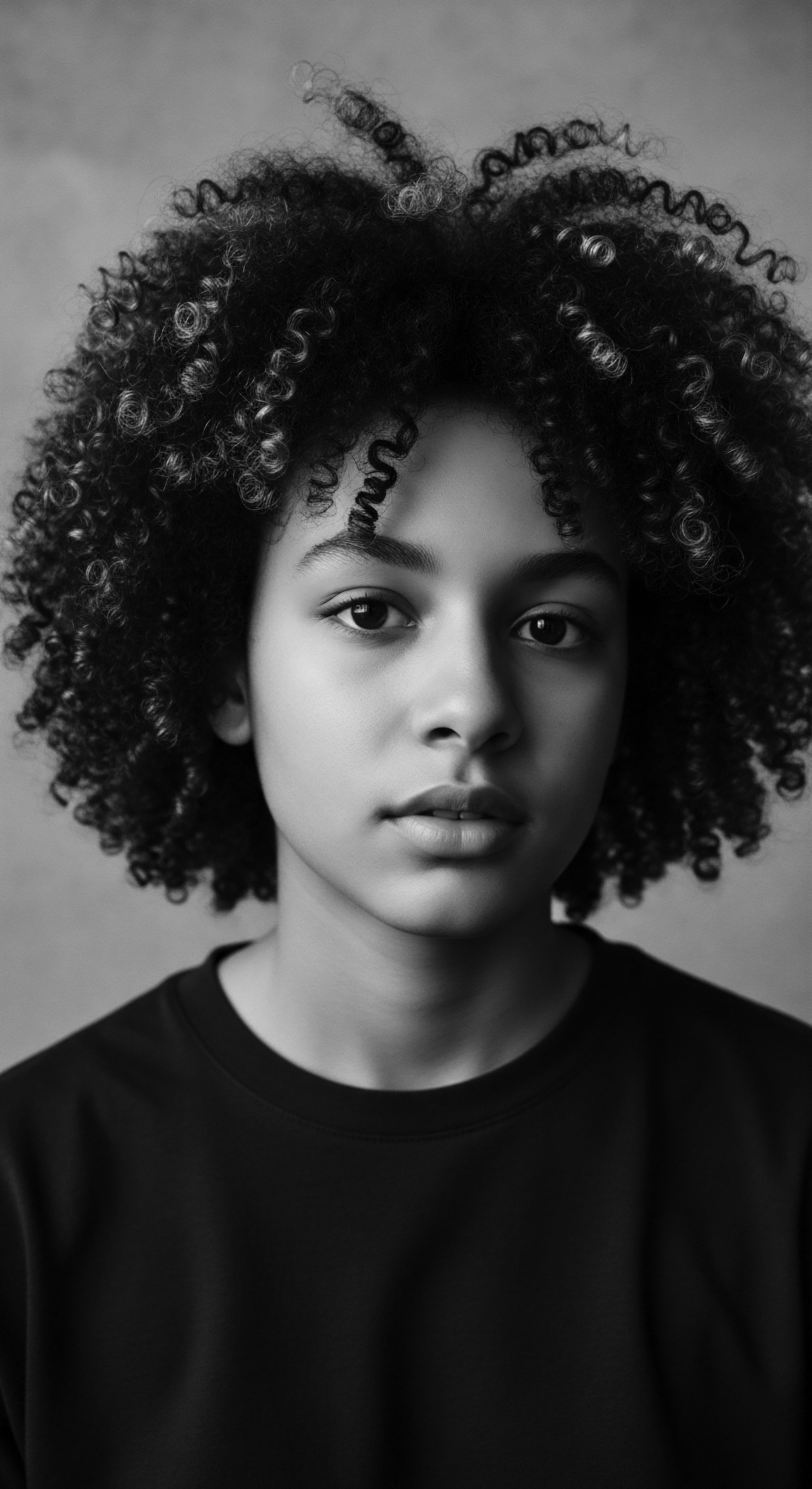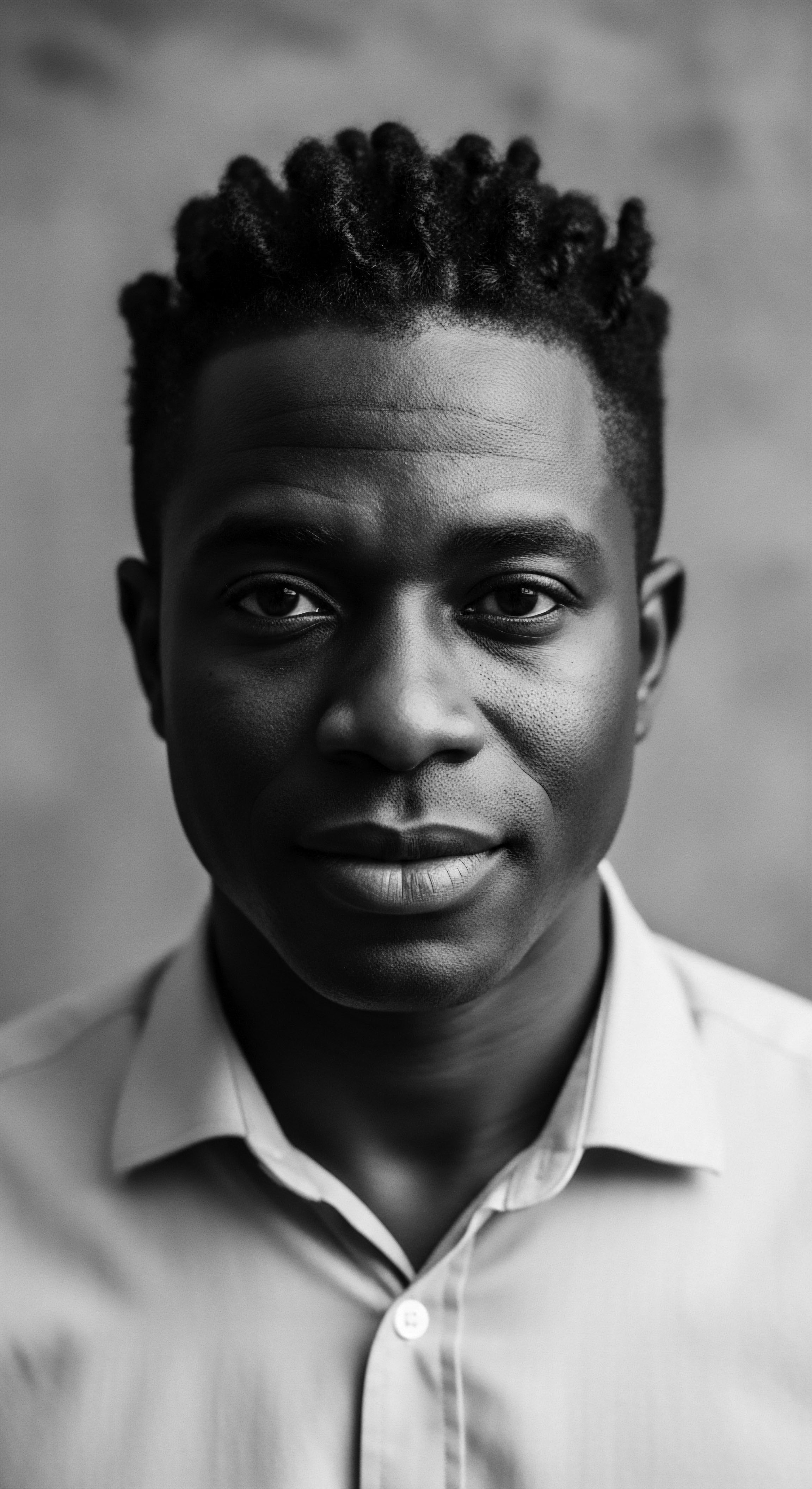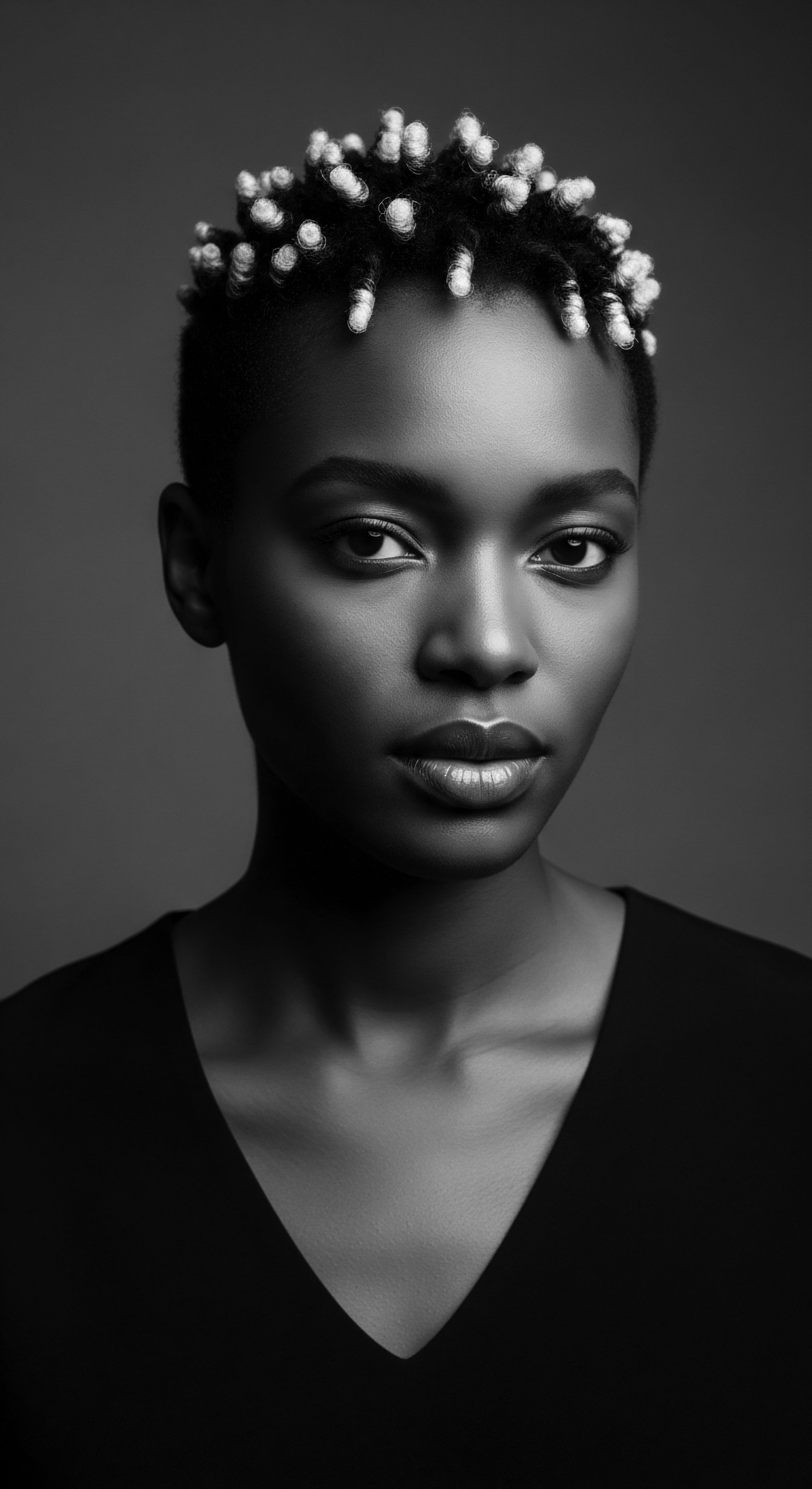
Fundamentals
The journey into understanding Ulmus Rubra Ethnobotany begins with a deep breath, inviting us to walk ancient pathways where nature’s gifts were held in profound esteem. To truly grasp its significance, particularly within the lineage of textured hair care, we first consider the elemental components of this extraordinary term. The Ulmus Rubra, commonly known as Slippery Elm, is a deciduous tree native to the expansive woodlands of eastern North America, stretching across regions from Texas to Quebec. Its presence graced the landscape long before colonial footsteps touched these shores, its inner bark a prized possession for centuries.
The core of its distinction resides in the inner bark, which, when moistened, yields a remarkable mucilaginous substance. This gel-like quality, so inherent to its very name, bestowed upon it a myriad of uses, ranging from sustenance during periods of scarcity to a versatile healing agent. Its natural ability to soothe and coat tissues made it a cherished component in various traditional remedies.

What is Ethnobotany?
Ethnobotany itself represents the bridge connecting human societies with the plant world. It is the scholarly pursuit of comprehending how different cultures, through the sweep of time, have interacted with and utilized plants for their well-being, sustenance, and ritual practices. This discipline seeks to unravel the intricate knowledge systems passed down through generations, recognizing plants not merely as biological specimens but as integral threads within the fabric of human existence.
It explores the shared wisdom of communities and their botanical companions, illuminating their deep reverence for the Earth’s offerings. The exploration of this term illuminates the dynamic, living relationship between people and the flora that shaped their lives.
Ethnobotany connects human societies with the plant world, revealing ancient wisdom woven into cultural practices.
When we consider the Ulmus Rubra through this lens, we are not simply looking at a tree; we perceive a profound relationship. Its uses were not random; they were born from observation, experimentation, and a collective understanding refined over countless generations. The knowledge of its soothing qualities, its capacity to nourish, and its ability to offer comfort from various ailments was a heritage, carefully stewarded. The early applications of this bark laid a groundwork, hinting at its potential to calm, to soften, and to ease, qualities that would later prove invaluable to those seeking gentleness for their coils and crowns.
- Ulmus Rubra ❉ A North American deciduous tree, also known as Slippery Elm, celebrated for its unique inner bark.
- Mucilage ❉ The gelatinous substance within the inner bark, a key component providing soothing and conditioning properties.
- Ancestral Recognition ❉ Indigenous peoples of North America were the original stewards of its botanical understanding, employing it for a spectrum of needs.
The simple meaning of Ulmus Rubra Ethnobotany, for those just beginning this contemplation, involves recognizing the rich history embedded within a seemingly humble tree. It is a testament to humanity’s enduring connection to nature’s pharmacy and larder. This initial glimpse sets the stage for a deeper contemplation of how this ancestral understanding found new purpose and resonance within the specialized context of textured hair traditions.

Intermediate
Moving beyond the foundational understanding, our contemplation of Ulmus Rubra Ethnobotany deepens, revealing the nuanced ways this botanical ally shaped communal practices and self-care rituals. The intrinsic worth of Ulmus Rubra for textured hair, especially, stems directly from its remarkable mucilage content. This viscous, polysaccharide-rich substance, once hydrated, transforms into a slick gel. Its significance for hair care is rooted in its capacity to mimic and enhance the natural slip and conditioning attributes often sought for coils and curls.

Bioactive Compounds and Their Hair Benefits
The mucilage of Ulmus Rubra is a complex mixture of polysaccharides, including D-galactose, L-rhamnose, and D-galacturonic acid. These compounds, when introduced to hair, offer a demulcent and emollient effect, which means they soothe and soften. For textured hair, which often possesses a more open cuticle layer making it susceptible to moisture loss, this property is vital.
The mucilage helps create a protective film along the hair strand, sealing in hydration and contributing to its overall pliability. This protective embrace helps to diminish frizz and offers a natural luster, honoring the hair’s inherent beauty.
Beyond its conditioning prowess, Ulmus Rubra also exhibits anti-inflammatory qualities. For the scalp, a healthy foundation for any vibrant hair, these properties are a true comfort. An irritated or dry scalp, prone to conditions like flakiness or itching, finds relief in the soothing application of the elm bark preparation. This gentle care promotes an environment conducive to healthy hair growth, strengthening the follicular anchor.

Historical Preparation Methods
Ancestral knowledge held the key to unlocking Ulmus Rubra’s gifts. The inner bark, rust-red and fragrant, was carefully harvested, typically in the spring when its properties were most potent. Preparing the bark often involved drying and then grinding it into a fine powder. This powdered form could then be mixed with water to create the celebrated gel, a base for various applications.
It was sometimes ingested as a porridge during times of need, speaking to its nutritive value. The adaptability of its preparation methods speaks to the resourcefulness of those who relied upon it, transforming a natural resource into a practical remedy.
Ulmus Rubra’s mucilage provides unparalleled slip and conditioning for textured hair, a testament to ancient wisdom.
Consider the simple ingenuity of these processes ❉ a tree’s inner bark transformed into a powerful balm with water, a universal element. This inherent simplicity meant that the remedy was accessible, not requiring complex tools or rare adjuncts. This accessibility made it a staple in household remedies, a whispered wisdom passed through generations.
Its efficacy in detangling, a common need for tightly coiled and curly textures, was, and remains, particularly noteworthy. The slippery quality allowed fingers or wide-toothed combs to glide through hair, reducing breakage and preserving the integrity of each strand, a true blessing for those maintaining often-fragile hair types.
The application methods varied across communities, yet the core principles remained consistent ❉ to cleanse, to soothe, and to fortify. The bark found its way into poultices for skin, teas for internal health, and, by extension of its demulcent nature, into topical applications for the hair and scalp. This breadth of traditional application underscores its versatile designation as a healing plant. The historical record, though often focused on broader medicinal uses, implicitly supports its relevance to practices involving hydration and structural care, qualities directly applicable to textured hair.
- Mucilaginous Properties ❉ Its chief characteristic, providing hydration, conditioning, and detangling for diverse hair types.
- Anti-Inflammatory Effects ❉ Soothes the scalp, establishing a supportive environment for hair vitality.
- Preparation Simplicity ❉ Ground inner bark mixed with water created a versatile gel, accessible across varied communities.
Understanding Ulmus Rubra at this intermediate level reveals not just its botanical attributes, but its enduring legacy as a practical solution, particularly for hair that craved gentle, effective care rooted in natural principles. It is a testament to the ancestral ingenuity that recognized and utilized the gifts of the earth for daily well-being.

Academic
The Ulmus Rubra Ethnobotany signifies a profound intellectual and cultural domain that examines the historical and contemporary relationships between human societies, particularly those with a deep heritage in natural resource utilization, and the tree species Ulmus rubra. This delineation extends beyond mere botanical identification, encompassing the intricate systems of knowledge, belief, and practice that have developed around the plant. It is an intersectional study, weaving together botanical science, cultural anthropology, historical sociology, and the nuanced understanding of health and aesthetic practices across distinct communities, with particular focus on textured hair heritage. The term’s meaning finds its deepest resonance in the careful preservation and scholarly analysis of ancestral wisdom, often obscured by colonial narratives, yet vitally present in the living memory of Black and mixed-race hair traditions.

Deep Roots ❉ The Indigenous Legacy and Diasporic Adaptation
At its intellectual foundation, Ulmus Rubra Ethnobotany is inseparable from the ancestral knowledge systems of Native American peoples. These communities, living in profound communion with the North American landscape for millennia, recognized Ulmus rubra’s unique properties long before European arrival. The inner bark, rich in a polysaccharide mucilage, was not only a demulcent for internal ailments—sore throats, digestive discomforts—and an external dressing for wounds, but also a nutritional staple during scarcity.
This deep, multifaceted utilization represents a sophisticated understanding of botanical chemistry and practical application, passed down through oral traditions and communal practice. Indeed, its significance was so pervasive that by 1913, the extensive debarking of slippery elms by settlers had already begun to impact native tree populations, indicating the widespread adoption of Indigenous knowledge into broader American household remedies (Gibson, 1913, as cited in Mountain Rose Herbs Blog).
The transfer of this traditional ecological knowledge from Indigenous healers to early European settlers is well-documented (Lloyd, 1911; Gilmore, 1919). This intellectual diffusion created a context where Ulmus rubra became a recognized part of the nascent American pharmacopoeia. What remains less formally documented, yet is academically compelling and culturally vital, is the indirect, yet arguably significant, pathway of this knowledge to enslaved Africans and their descendants in North America. These communities were forcibly dispossessed of their ancestral lands, their traditional African plant knowledge, and their established hair care rituals.
In the crucible of the Americas, resilience manifested as an extraordinary capacity for adaptation and innovation. Enslaved and free Black women, facing the harsh realities of forced labor and inadequate resources, consistently sought out local alternatives to maintain their hair, which remained a profound symbol of identity, resistance, and self-worth.

A Case Study in Ethnobotanical Adaptation ❉ The Silent Passage of Care
Consider the arduous conditions faced by enslaved Black women on plantations across the American South. Their hair, tightly coiled and often prone to extreme dryness and tangling, required diligent care that was rarely afforded in their brutalized daily lives. Traditional African ingredients and elaborate styling tools were largely inaccessible, stripped away by the transatlantic slave trade.
In this context of profound deprivation and enforced adaptation, any accessible plant offering relief for hair or scalp would have been invaluable. The mucilage of Ulmus rubra, known for its conditioning, detangling, and soothing properties for skin and mucous membranes, presented a readily available, effective solution in the immediate environment.
In the crucible of enslavement, Black women’s ingenuity transformed local flora into essential hair care, a silent testament to enduring heritage.
While direct, written accounts of enslaved African Americans using slippery elm bark specifically for hair conditioning are scarce—a reflection of the systemic suppression of their histories and the oral nature of much of their knowledge transmission—the scientific principles underpinning its suitability are clear. The bark’s capacity to create a gel with exceptional slip would have been an undeniable asset for detangling matted, coarse textures, minimizing breakage during a period when hair preservation was both a practical necessity and a quiet act of defiance. The anti-inflammatory benefits would have soothed scalps often subjected to harsh conditions and lack of proper hygiene.
Thus, the logical inference, supported by the broader ethnobotanical record of adaptive resourcefulness within diasporic communities, suggests that Ulmus rubra, a prominent local demulcent, became a silent ally in the ongoing struggle for self-preservation and dignity through hair care. This adaptation speaks to a dynamic process of knowledge exchange, where ancestral African resilience met Indigenous plant wisdom, leading to new forms of care within the constraints of a new, often hostile, environment.
This intellectual approach to Ulmus Rubra Ethnobotany, especially regarding textured hair, compels us to consider the pathways of knowledge transfer beyond formal documentation. The necessity of maintaining hair, for both practical reasons and as a connection to a fragmented identity, would have driven the exploration of local flora. The prevalence of Ulmus rubra in eastern North American ecosystems made it a visible, accessible resource for all inhabitants, regardless of their origin.

Multicultural Facets and Interconnected Incidences
The understanding of Ulmus Rubra Ethnobotany is multi-layered, showing how a single botanical entity can hold diverse, yet interconnected, significances across cultures.
| Community Native American Nations |
| Primary Ethnobotanical Application Food, internal medicine (digestive, respiratory), wound healing, childbirth aid. |
| Potential Relevance to Textured Hair Heritage Original knowledge source for mucilage's soothing and demulcent properties; foundational understanding of its topical efficacy for skin, logically extending to scalp and hair health. |
| Community European Settlers |
| Primary Ethnobotanical Application Adopted Indigenous medicinal uses for household remedies and pharmacopoeia. |
| Potential Relevance to Textured Hair Heritage Integrated Ulmus Rubra into wider American knowledge, increasing its general availability and recognition, creating pathways for broader communal use. |
| Community Black/Mixed-Race Communities (Diaspora) |
| Primary Ethnobotanical Application Likely adaptive use for practical self-care, including hair, given resource scarcity and need for detangling/conditioning. |
| Potential Relevance to Textured Hair Heritage Embodiment of ancestral resilience; adaptation of local flora for distinct hair needs; silent preservation of self-dignity through hair maintenance. |
| Community The varied uses of Ulmus Rubra underscore its adaptability and the ingenious ways different cultures utilized available resources for well-being. |
The interconnectedness lies in the shared physical presence of the tree and the universal human need for well-being. While Indigenous peoples possessed a deeply integrated spiritual and medicinal relationship with Ulmus rubra, European settlers recognized its practical medical value. For African American communities, navigating a new, often hostile environment, the plant’s proven ability to soothe and condition, whether learned directly or adapted through observation of its general efficacy, would have been a profoundly practical asset.
The continuous lineage of hair care, even under duress, became a powerful marker of identity and survival, with plants like Ulmus rubra potentially serving as quiet, yet vital, agents in this complex cultural history. The long-term consequences of this ethnobotanical adaptation include the continued presence of Ulmus rubra as a respected ingredient in contemporary natural hair care, a modern echo of ancestral ingenuity.

Contemporary Resonance and Future Contemplations
The academic study of Ulmus Rubra Ethnobotany within the context of textured hair heritage encourages a re-evaluation of what constitutes “validated” knowledge. While modern scientific studies confirm the mucilage’s conditioning, detangling, and anti-inflammatory properties, these validations often affirm insights held by traditional practitioners for centuries. The challenge for contemporary scholarship is to bridge this gap, to properly credit the originators of this knowledge, and to explore the socio-historical complexities that shaped its transmission and adaptation.
The future of Ulmus Rubra Ethnobotany demands a commitment to sustainability, recognizing the environmental pressures on the species due to historical overharvesting and disease. Preserving the tree ensures the continuation of its potential benefits, but also honors the living legacy of Indigenous wisdom. For textured hair care, it means celebrating a lineage of resourcefulness, acknowledging that the slip and conditioning we seek today find their genesis in the ancient barks and enduring spirits of those who first understood the Earth’s profound offerings.
The continuous examination of Ulmus Rubra Ethnobotany provides a deeper understanding of human adaptability, the resilience of cultural practices, and the subtle yet powerful role of botanical allies in shaping identity through the generations. It serves as a reminder that the path to true wellness often loops back to the earth, to ancestral voices, and to the inherent wisdom held within the natural world itself.
- Mucilage ❉ The primary active component, a complex polysaccharide, responsible for its remarkable soothing and conditioning properties.
- Traditional Applications ❉ Historically utilized by Native American nations for a broad range of medicinal and nutritional purposes.
- Diasporic Adaptations ❉ Its presence in North America suggests its likely, albeit often undocumented, adoption by African and mixed-race communities for hair care amidst resource scarcity.

Reflection on the Heritage of Ulmus Rubra Ethnobotany
To stand at this precipice of understanding Ulmus Rubra Ethnobotany is to feel the gentle rustle of leaves carrying whispers from generations past. It is more than a botanical definition; it represents a living archive, breathing with the fortitude and ingenuity of those who came before. In contemplating this remarkable tree and its enduring significance for textured hair, we connect with the profound “Soul of a Strand”—the idea that each coil and curl carries not just genetic information, but also the echoes of ancestral resilience, adaptation, and profound self-love.
The story of Ulmus Rubra for hair care is a quiet testament to a boundless spirit. It speaks to the African diaspora’s resourcefulness, the ability to find beauty, comfort, and function in an environment often hostile and unfamiliar. When traditional elements were out of reach, ingenious hands reached for what the new land offered, adapting ancient wisdom to new botanical realities. This is a powerful heritage, teaching us that care is not merely about ingredients; it is about intention, connection, and the deep-seated impulse to honor one’s self, one’s lineage, even in the most challenging circumstances.
The continued presence of Ulmus rubra in modern hair preparations, particularly those for coils and curls, serves as a beautiful, unbroken thread. It reminds us that the quest for hair health is not a modern invention; it is a timeless practice, steeped in histories that deserve our deepest respect and celebration. This heritage invites us to move with deliberate steps, acknowledging the Indigenous roots of this knowledge, and recognizing the layers of cultural adaptation that have brought it into our present understanding.
Our contemplation concludes with a sense of reverent wonder. The Ulmus Rubra, in its unassuming strength, offers a reflection of the textured hair journey itself ❉ resilient, deeply rooted, and endlessly adaptable. It encourages a mindful approach to care, one that sees beyond the product to the profound cultural narratives embedded within each natural ingredient. May this understanding deepen our appreciation for every strand, a testament to enduring beauty, strength, and heritage.

References
- Gibson, H. H. (1913). American Forest Trees. Retrieved from Mountain Rose Herbs Blog (as cited).
- Gilmore, M. R. (1919). Uses of Plants by the Indians of the Missouri River Region. University of Nebraska Press.
- Langmead, L. et al. (2002). Antioxidant effects of six herbal therapies used to treat inflammatory bowel disease. Phytotherapy Research, 16(2), 174-175.
- Lloyd, J. U. (1911). History of the Vegetable Drugs of the Pharmacopeia of the United States. Harvey Publishing Company.
- Moerman, D. E. (1998). Native American Ethnobotany. Timber Press.
- Stearns, S. (1801). The American Herbal; Or, Materia Medica. Lincoln & Edmands.
- Sumner, J. (2004). The Natural History of Medicinal Plants. Timber Press.
- Tharps, L. M. & Herndon, A. (2001). Hair Story ❉ Untangling the Roots of Black Hair in America. St. Martin’s Publishing.
